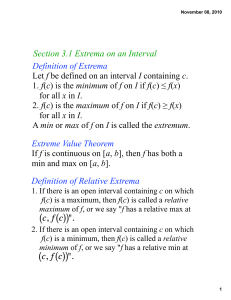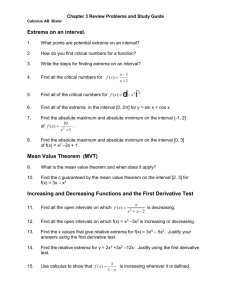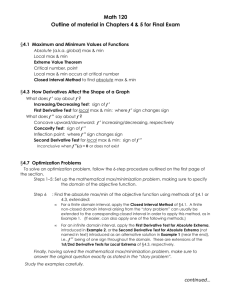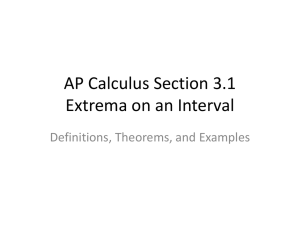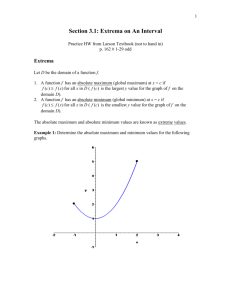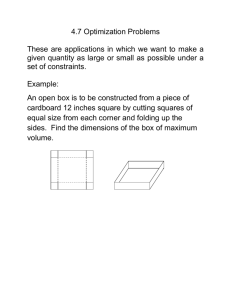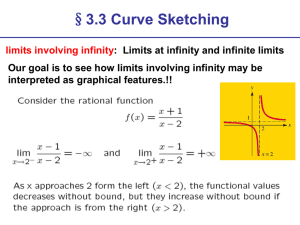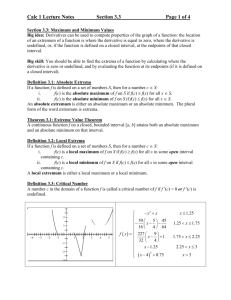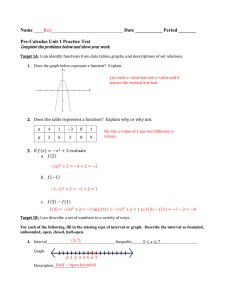Extrema of a Function
advertisement
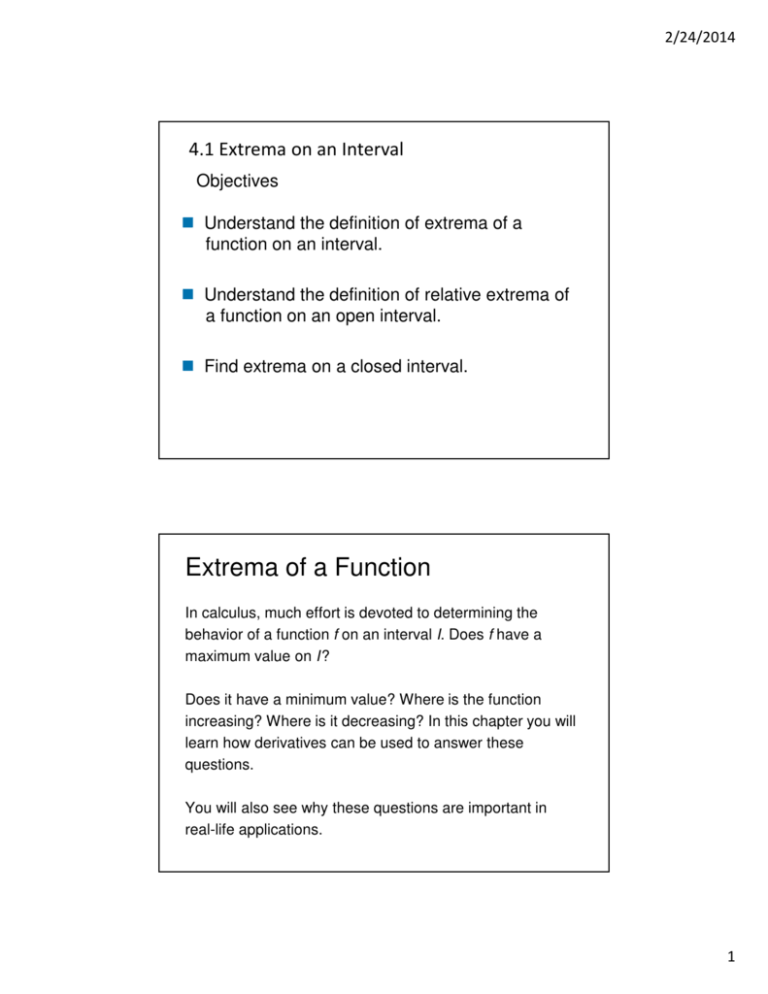
2/24/2014 4.1 Extrema on an Interval Objectives Understand the definition of extrema of a function on an interval. Understand the definition of relative extrema of a function on an open interval. Find extrema on a closed interval. Extrema of a Function In calculus, much effort is devoted to determining the behavior of a function f on an interval I. Does f have a maximum value on I? Does it have a minimum value? Where is the function increasing? Where is it decreasing? In this chapter you will learn how derivatives can be used to answer these questions. You will also see why these questions are important in real-life applications. 1 2/24/2014 Three Examples 2 2/24/2014 Relative Extrema • Can typically think of these as the “peaks” and “valleys” of a graph. 3 2/24/2014 The Value of the Derivative at Relative Extrema Find the value of the derivative at each relative extremum shown in Figure 4.3. Figure 4.3 (a) – Solution The derivative of Differentiate using Quotient Rule. Simplify. At the point (3, 2) the value of the derivative is f′(3) = 0 [see Figure 4.3(a)]. 4 2/24/2014 (b) – Solution cont’d At x = 0, the derivative of f(x) = |x | does not exist because the following one-sided limits differ [see Figure 4.3(b)]. Limit from the left Limit from the right f ′(0) does not exist. Figure 4.3(b) (c) – Solution cont’d The derivative of f(x) = sin x is f′(x) = cos x. At the point (π /2, 1), the value of the derivative is f′(π /2) = cos(π / 2) = 0. At the point (3π /2, –1), the value of the derivative is f′(3π /2) = cos(3π / 2) = 0 [see Figure 4.3(c)]. Figure 4.3 5 2/24/2014 Relative Extrema and Critical Numbers Note in the example that at each relative extremum, the derivative either is zero or does not exist. The x-values at these special points are called critical numbers. Figure 4.4 illustrates the two types of critical numbers. c is a critical number of f. Figure 4.4 Relative Extrema and Critical Numbers Notice in the definition that the critical number c has to be in the domain of f, but c does not have to be in the domain of f′. 6 2/24/2014 Finding Extrema on a Closed Interval Theorem 4.2 states that the relative extrema of a function can occur only at the critical numbers of the function. Knowing this, you can use the following guidelines to find extrema on a closed interval. Finding Extrema on a Closed Interval The next example show how to apply these guidelines. Be sure you see that finding the critical numbers of the function is only part of the procedure. Evaluating the function at the critical numbers and the endpoints is the other part. 7 2/24/2014 Example – Finding Extrema on a Closed Interval Find the extrema of f(x) = 3x 4 – 4x3 on the interval [–1, 2]. Solution: Begin by differentiating the function. f(x) = 3x 4 – 4x3 Write original function. f′(x) = 12x3 – 12x2 Differentiate. To find the critical numbers of f in the interval (–1, 2), you must find all x-values for which f′(x) = 0 and all x-values for which f′(x) does not exist. Example – Solution f′(x) = 12x3 – 12x2 = 0 12x2(x – 1) = 0 x = 0, 1 cont’d Set f ′(x) equal to 0. Factor. Critical numbers Because f′ is defined for all x, you can conclude that these are the only critical numbers of f. 8 2/24/2014 Example – Solution cont’d By evaluating f at these two critical numbers and at the endpoints of [–1, 2], you can determine that the maximum is f(2) = 16 and the minimum is f(1) = –1, as shown in the table. Example – Solution cont’d The graph of f(x) is shown in Figure 4.5. On the closed interval [–1, 2], f has a minimum at (1, –1) and a maximum at (2, 16). Figure 4.5 9 2/24/2014 Finding Extrema on a Closed Interval In Figure 4.5, note that the critical number x = 0 does not yield a relative minimum or a relative maximum. This tells you that the converse of Theorem 4.2 is not true. In other words, the critical numbers of a function need not produce relative extrema. Example f ' ( x) = ( x 2 + 1)(4) − (4 x)(2 x) ( x 2 + 1) 2 = 4(1 − x 2 ) ( x 2 + 1) 2 Critical numbers: 1-x 2 = 0 There are not values for which f ' does not exist. x2 = 1 x = ±1 10 2/24/2014 Example (cont.) f ' (θ ) = 2sec θ tan θ + sec 2 θ = sec θ (2 tan θ + sec θ ) sin θ = sec θ 2 cos θ 1 + cosθ critical numbers in (0,2π ): 7π 11π θ= , 6 6 2sin θ + 1 = sec θ cos θ = sec 2 θ (2sin θ + 1) Example (cont.) 1 g ' (t ) = 2 ln t + 2t t = 2 ln t + 2 Critical number: 2 ln t + 2 = 0 ln t = −1 t = e −1 = 1 e 11 2/24/2014 Locating Extrema Example f ' ( x) = 3 x 2 − 12 = 3( x 2 − 4) 12 2/24/2014 Example (cont.) Example 13 2/24/2014 Example 14
